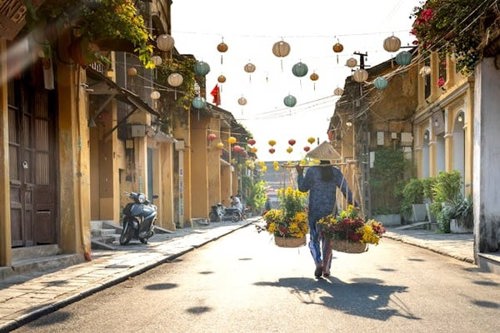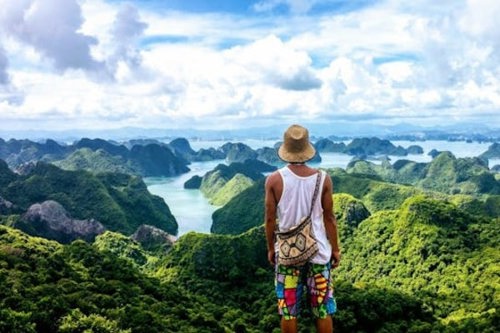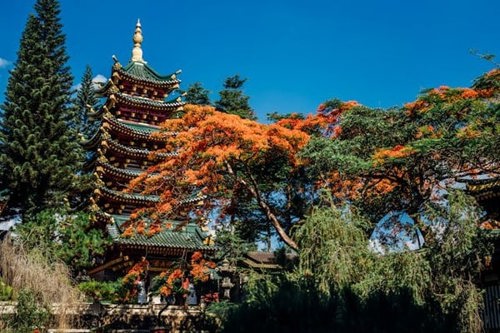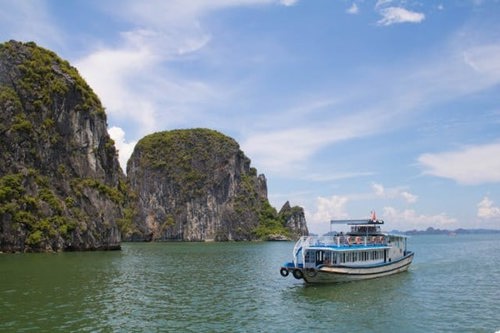Vietnam, an Asian gem nestled along the eastern edge of the Indochinese peninsula, is a nation of jewel-like greenery, vibrant cities, and a rich, complex history. Whether you want to enjoy its delicious cuisine, walk in beautiful surroundings, take a cruise through the emerald water of UNESCO-listed Ha Long Bay, or visit ancient shrines, Vietnam offers something for everyone.
The question of when to visit Vietnam can be complex, given the length of the country and its diverse climate, influenced by monsoons. This guide aims to paint a vivid picture of Vietnam’s seasonal variations, offering insights to help you find the best time to visit Vietnam.
The Best Season to Visit Vietnam
Vietnam’s elongated geographical layout means its climate varies significantly from north to south. Whether you’re enticed by the bustling life of cities like Hanoi or Ho Chi Minh City, the serene beauty of Ha Long Bay, or the cultural surprises of ancient towns like Hoi An, there’s a perfect time to immerse yourself in each experience. Our Vietnam Escorted Tours are carefully crafted to encapsulate the country’s essence at ideal times throughout the year thanks to experienced local guides. Let’s look at how Vietnam changes over the seasons.
Spring in Vietnam

Spring in Vietnam, which falls between March and May, is generally warm and dry, making it an ideal time for outdoor activities and exploring Vietnam's cultural offerings. It's a wonderful season to witness the country's stunning landscapes, from the terraced rice fields surrounding Hoi An to the scenic beauty of Ha Long Bay.
| |
March
|
April
|
May
|
|
North - Hanoi, Ha Long Bay
|
|
|
|
|
Average temperature °C
|
21
|
24
|
28
|
|
Average temperature °F
|
69
|
74
|
82
|
|
Central - Hoi An, Hue,
|
|
|
|
|
Average temperature °C
|
25
|
28
|
29
|
|
Average temperature °F
|
75
|
82
|
83
|
|
South - Ho Chi Minh City, Can Tho
|
|
|
|
|
Average temperature °C
|
29
|
30
|
30
|
|
Average temperature °F
|
84
|
86
|
86
|
Some of the best things to try in Vietnam in the spring include these highlights:
-
Enjoy Hanoi: The city’s French-influenced streets come alive with the beautiful pastel colours of blossoming flowers in stark contrast to the noisy sound of mopeds rushing by.
-
Sail through Ha Long Bay: The iconic limestone karsts are veiled in mystique with the spring mist.
If you are looking for a truly memorable experience in Vietnam’s spring, try our Invitation to Vietnam & the Temples of Angkor Tour. This guided tour offers you an exciting itinerary. From rickshaw tours of bustling Hanoi, to cruising Ha Long Bay and the lively streets of Ho chi Minh City, you’ll be able to see the very best that the country has to offer.
Summer in Vietnam

Summer in Vietnam, spanning from June to August, brings warm and humid weather, particularly in the north. This season is perfect for enjoying the country's extensive coastline. However, be prepared for occasional rain in the south. The weather at this time can be too hot for outdoor pursuits at times, but it is a great season to explore the cities and visit ancient shrines and temples.
| |
June
|
July
|
August
|
|
North - Hanoi, Ha Long Bay
|
|
|
|
|
Average temperature °C
|
29
|
29
|
28
|
|
Average temperature °F
|
83
|
83
|
82
|
|
Central - Hoi An, Hue,
|
|
|
|
|
Average temperature °C
|
30
|
30
|
29
|
|
Average temperature °F
|
85
|
85
|
83
|
|
South - Ho Chi Minh City, Can Tho
|
|
|
|
|
Average temperature °C
|
29
|
28
|
29
|
|
Average temperature °F
|
83
|
82
|
83
|
Key experiences in Vietnam in the summer:
-
Experience Hoi An: Wander through this ancient town with lantern-lit evenings and its many tailor shops where you can get bespoke clothing made.
-
Explore Hue: Take a boat trip on the Perfume River.
-
Indulge your taste buds: Savour fresh seafood at it's best time of year.
Autumn in Vietnam

Autumn in Vietnam, from September to November, is a season of cooler and more comfortable weather, with less humidity. It's a great time for exploring cities and cultural sites like Hanoi and Hue. The country's stunning rice terraces become golden landscapes as the rice is harvested. Autumn is perfect for experiencing local life, as this season coincides with the harvest festivals celebrated by various ethnic groups.
| |
September
|
October
|
November
|
|
North - Hanoi, Ha Long Bay
|
|
|
|
|
Average temperature °C
|
28
|
25
|
22
|
|
Average temperature °F
|
82
|
77
|
71
|
|
Central - Hoi An, Hue,
|
|
|
|
|
Average temperature °C
|
28
|
27
|
24
|
|
Average temperature °F
|
82
|
80
|
75
|
|
South - Ho Chi Minh City, Can Tho
|
|
|
|
|
Average temperature °C
|
28
|
28
|
27
|
|
Average temperature °F
|
82
|
82
|
81
|
Top things to do in Vietnam in the autumn include these:
-
Wander through Hue: Explore Vietnam’s ancient capital with pleasant weather.
-
Take in the glow of Hoi An: With darker evenings, Hoi An makes a picture perfect place to take a stroll at the end of the day as colourful latern displays fill shop fronts and couples take boat journeys down Thu Bồn River placing floating candles in the water as they make a wish.
For a truly memorable experience that makes the most of Vietnam in the autumn, have a look at our Journey through Southeast Asia Tour. With our guided tour you can watch a water puppet show, explore the temples at Angkor Wat in Cambodia, and truly immerse yourself in the vibrant culture of this compelling region.
Winter in Vietnam

Winter in Vietnam, from December to February, offers a diverse experience depending on the region. In the north, especially Hanoi, temperatures can be quite cool, but the skies are often clear. It's an ideal time for walking and exploring. Central Vietnam experiences milder weather, perfect for visits to cities like Hoi An and Da Nang. The south remains warm and dry, with Ho Chi Minh City offering a pleasant escape from the cooler temperatures in the north.
If you visit in January or February you may be lucky enough to experience the Lunar New Year (Tet) celebrations. The entire country comes alive with vibrant flower markets, traditional dragon and lion dances, and special dishes.
| |
December
|
January
|
February
|
|
North - Hanoi, Ha Long Bay
|
|
|
|
|
Average temperature °C
|
18
|
17
|
17
|
|
Average temperature °F
|
64
|
63
|
63
|
|
Central - Hoi An, Hue,
|
|
|
|
|
Average temperature °C
|
22
|
21
|
22
|
|
Average temperature °F
|
71
|
69
|
71
|
|
South - Ho Chi Minh City, Can Tho
|
|
|
|
|
Average temperature °C
|
27
|
27
|
28
|
|
Average temperature °F
|
80
|
80
|
82
|
Here are some top things to try in Vietnam in the winter:
-
Ho Chi Minh City: Explore the city’s French colonial architecture and vibrant street life.
-
Mekong Delta: Navigate through the intricate waterways and floating markets.
-
Take a culinary tour: Explore Hanoi's unique winter cuisine, including hot bowls of pho and bun cha.
The best month to visit Vietnam
January
Best for: City tours, cultural immersion
With cool weather in the north and mild temperatures in the south, this is an excellent time to explore Hanoi’s rich history and enjoy the dry, mild weather in Ho Chi Minh City.
February
Best for: Tet celebrations and warm vacations
The weather starts to gradually warm, especially in central and southern parts. Witness Tet festivities as you explore this impressive country.
March
Best for: Nature explorations and cultural tours
Mild temperatures and low rainfall make this month an ideal time for exploring countryside and cities alike. From Hoi An’s ancient architecture and river life to the stunning vistas of Ha Long Bay.
April
Best for: Coastal vacations and outdoor activities
The weather becomes warm, with the north experiencing occasional showers.
May & June
Best for: Sunny holidays, mountain retreats
The weather can be rainy in the north, but the central coast remains sunny and vibrant. This is a great time to trek in northern mountains or unwind in coastal towns like Nha Trang.
July & August
Best for: Hot holidays, exploring southern Vietnam
With summer at its peak, this is ideal for vacations in the warm countryside. Or, Ho Chi Minh City’s urban streets are at their best.The weather is warm and rainy, making it ideal for lush, scenic views in the highlands.
September
Best for: Nature and wildlife tours, outdoor activities
The moderate temperatures and reduced rainfall make this time ideal for exploring national parks.
October
Best for: Water excursions, harvest flavours
Take to the water with a river cruise along the Perfume River in Hue or float past the iconic limestones of Ha Long Bay. Try some seasonal dishes as harvest is in full swing.
November
Best for: Exploring the north, warmer vacations in the south
Explore Hanoi’s cultural and French legacy, and enjoy retreats in the south to make the most of the warmer weather in this part of the country.
December
Best for: Urban explorations
With the cooler weather, this is an ideal time for exploring southern cities. Or, visit the Mekong Delta for spotting wildlife along waterways.

Insider Tips for Timing Your Visit
When considering the timing of your visit, you need to look at a few factors:
-
Climate variations: Vietnam’s diverse climate necessitates detailed planning based on your specific regions of interest.
-
Cultural events: If you want to catch a glimpse of local festivals on your adventure in Vietnam, be sure to check which season the festival may be in or if your holiday dates coincide.
-
Your ideal holiday: Do you want to enjoy winter in the bustling cities, or walk through national parks? Pick the right weather for your adventure.
When to Go to Vietnam: Summary
Vietnam, with its diversity of climate and terrain, along with its vast cultural opportunities, offers distinct experiences each month. The north is characterised by frosty winters and summers, while the south remains moderately warm year-round. Central Vietnam is known for its sunny summers, making it a haven for hot weather enthusiasts. Every season, from the festive spring and wet but sunny summers to the scenic autumns and serene winters, reveals a unique facet of Vietnam’s charm.
Whether you're roaming the bustling streets of Hanoi, cruising through the ethereal landscapes of Ha Long Bay, relishing the historical grandeur of Hue, or basking on the sunny countryside of Nha Trang, each experience is time-specific. Our carefully crafted Vietnam Escorted Tours promise to be your companion in every soul-stirring escapade, with over 60s year of experience, you can be assured that each tour has been designed to go beyond the guidebook so you truly experience the best that Vietnam offers. Whether you want to enjoy local food or visit historical sites, our guided tours are ideal to help you see the best of the country.







